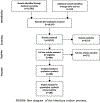Aging and recognition memory: A meta-analysis
- PMID: 30640498
- PMCID: PMC6481640
- DOI: 10.1037/bul0000185
Aging and recognition memory: A meta-analysis
Abstract
Recognizing a stimulus as previously encountered is a crucial everyday life skill and a critical task motivating theoretical development in models of human memory. Although there are clear age-related memory deficits in tasks requiring recall or memory for context, the existence and nature of age differences in recognition memory remain unclear. The nature of any such deficits is critical to understanding the effects of age on memory because recognition tasks allow fewer strategic backdoors to supporting memory than do tasks of recall. Consequently, recognition may provide the purest measure of age-related memory deficit of all standard memory tasks. We conducted a meta-analysis of 232 prior experiments on age differences in recognition memory. As an organizing framework, we used signal-detection theory (Green & Swets, 1966; Macmillan & Creelman, 2005) to characterize recognition memory in terms of both discrimination between studied items and unstudied lures (d') and response bias or criterion (c). Relative to young adults, older adults showed reduced discrimination accuracy and a more liberal response criterion (i.e., greater tendency to term items new). Both of these effects were influenced by multiple, differing variables, with larger age deficits when studied material must be discriminated from familiar or related material, but smaller when studying semantically rich materials. These results support a view in which neither the self-initiation of mnemonic processes nor the deployment of strategic processes is the only source of age-related memory deficits, and they add to our understanding of the mechanisms underlying those changes. (PsycINFO Database Record (c) 2019 APA, all rights reserved).
Figures



References
-
- Anastasi JS, & Rhodes MG (2006). Evidence for an own-age bias in face recognition. North American Journal of Psychology, 8, 237–252. doi:10.3758/BF03206441 - DOI
Publication types
MeSH terms
Grants and funding
LinkOut - more resources
Full Text Sources
Medical
Research Materials

